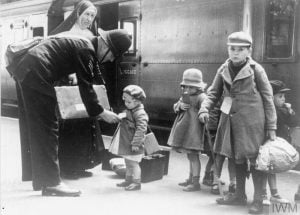Sports days? School lunches? Uniforms? As we approach the end of summer, children everywhere are getting ready to go back to school. Even though school might be different from country to country, children all over the world share similar experiences. We gathered memories from people who attended school in different parts of the world to highlight both differences and similarities. School Day Memories in Scotland Story Shared by Maggie I went to primary (elementary) school in a Victorian … [Read more...]
Babies Left Behind: researching unknown G.I. fathers in the United Kingdom during WW2
At the beginning of 1942, the first group of American G.I.s landed in the United Kingdom to help the war effort. Before long, there were US troops stationed up and down the country. To bridge the cultural gap between life in the U.S. and the U.K., as well as offer entertainment to troops, the American Red Cross set up clubs in larger towns and cities. Places like Rainbow Corner near Piccadilly Circus in London, and smaller local venues near military bases, hosted dances and other … [Read more...]
What Is Genealogy? How To Get Started With Family History Research
What is genealogy? What do you need to know to create a solid foundation for your family history research? What is a family tree, and how create an accurate family tree? How can you use DNA to help you with your research? We'll answer these questions and more for anyone who wants to find their ancestors anywhere in the world. What is genealogy? Genealogy can take many different forms, but what does it really mean? Is it simply names, dates, and places? Is it discovering deep roots at home or … [Read more...]
A Family in Stitches: Genealogical Information From a Scottish Embroidery Sampler
Genealogical information is often found in unlikely places. Check out the familial details included in this Scottish embroidery sampler! In 1885 my great-grandmother, Isabella Fairbairn, was 10 years old. She lived in a rural area of the Scottish borders, and like most Scottish children between the ages of 5 and 13, schooling was compulsory for her. Isabella attended school at Crailing, about 5 miles outside the market town of Jedburgh. We might never have known this, had she not … [Read more...]
Charles Booth’s London Poverty Maps: A Glimpse Into the Lives of Your Ancestors
If your ancestors lived in London at the end of the 1800s, the digitized Booth poverty maps provide fascinating insight into neighborhoods and standards of living in the city. The maps form part of Charles Booth’s, Inquiry into the Life and Labour of the People in London, a study conducted between 1886 and 1903. Booth was a Victorian philanthropist and a successful businessman. I have several ancestors who lived in London during that time, so I decided to see what could be gleaned about their … [Read more...]
What Language Did My Scottish Ancestors Really Speak?
Have you ever stopped to think about the language that your Scottish ancestors spoke? Gaelic? English? Something else? The answer is not as straightforward as you may think. English has been the “official” language of Scotland since the 18th century. Prior to this, Scots Gaelic had already been systematically suppressed by several acts of parliament, starting at the beginning of the 1600s.[1] One of the last Scottish kings to speak Gaelic was James IV who reigned from 1473 to 1513. … [Read more...]






